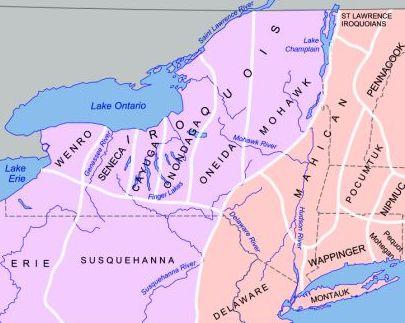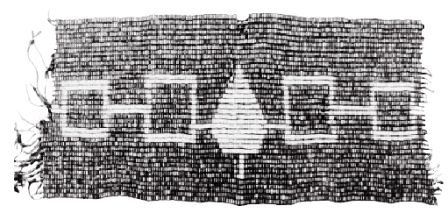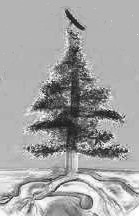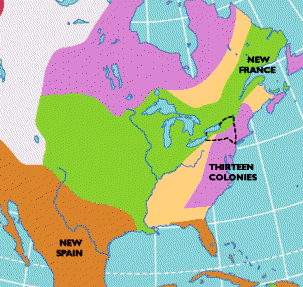History of the Iroquois Confederacy
The Iroquois Confederacy was initially a league of five tribes who inhabited New York State living between the Hudson River and the St Lawrence and Lake Erie. The tribes spoke the Iroquoian language which was a family of North American Indian languages spoken by the Iroquois peoples. The Iroquois gave their name to the Iroquoian branch of the Hokan-Siouan linguistic stock. Discover interesting history, facts and information about the Confederacy and its founders Deganawida and his spokesman Hiawatha, the tribes of the league, where they were located, the Constitution, the People of the Longhouse, the Hiawatha Wampum Belt, the Tree of Peace, Great Law of Peace and the Great Council.
Iroquois Confederacy Constitution
Iroquois Confederacy Tribes
The Iroquois were also known as the Haudenosaunee or the "People of the Longhouse". The Longhouse was a long, narrow house that was traditionally built by the Iroquois. The tribes of the Iroquois confederacy belonged to Eastern Woodlands culture group. The union created a powerful alliance of related Iroquoian tribes and peoples. The Iroquois Confederacy was also known as the "League of Peace and Power".
Iroquois Confederacy Tribes
The Iroquoian Confederacy was first founded c1550, prior to major European contact, and initially consisted of five tribes: the Mohawk, Oneida, Onondaga, Cayuga and Seneca tribes, which were known as the Five Nations. The Tuscarora tribe joined the Confederacy in 1722, as non-voting members of the league, and the collective tribes became known as the Six Nations. The powerful, and brutal, Iroquois coalition grew quickly by invading neighboring tribes and absorbing their land into Iroquois territory. The Iroquois Confederacy aimed to create an empire by incorporating subservient, conquered peoples.
Iroquois Confederacy Map - Territory of each of the Tribes
The Iroquoian Confederacy initially consisted of five tribes who were in close proximity of the Iroquois territory.
- The Mohawk tribe lived along the Mohawk River of the Mohawk Valley in upstate New York to South Quebec and East Ontario - Possessors of the Flint.
- The Seneca tribe lived in New York State south of Lake Ontario and were the were the largest nation of the Iroquois Confederacy - Great Hill People
- The Onondaga tribe lived between Lake Champlain and the Saint Lawrence River - People on the Hills
- The Oneida tribe lived east of Lake Ontario, around Oneida Lake - Granite People
- The Cayuga tribe lived around around Cayuga Lake in New York State - People of the Great Swamp
The Iroquois Confederacy map shows the locations and territory of the tribes in the league, before the Europeans arrived.

Map of Iroquois territory and the location of each of the tribes
The neighboring tribes were conquered by the Iroquoian Confederacy and their lands absorbed into their territory.
History of the Iroquois
The Iroquois nation were a war-like people and there was continuous inter tribal warfare and conflicts with the tribes of the Powhatan Confederacy. The young warriors were trained to become immune to pain and they had little respect for any signs of weakness. Honor was acquired by bravery and aggression in warfare. The Iroquoian tribes were merciless in their treatment of their enemies and captives who were tortured and sometimes roasted alive - their remains were consumed in cannibalistic feasts. Their incessant warfare was weakening the Iroquois tribes which became a major concern of two men. The prophet Deganawida who was a spiritual leader and his disciple Hiawatha who was a wise man, chief of the Onondaga tribe who acted as the spokesman for Deganawida.
Founding of the Iroquois Confederacy or League
Deganawida and Hiawatha travelled across Iroquois territory talking about their ideas and eventually took their message of peace to a council meeting of the five nations, or tribes. Dekanawida and Hiawatha united them into a League of Nations or the Iroquois League. They brought a message, known as the Great Law of Peace, to the warring Iroquoian nations. The Great Law of Peace was the basis of the Iroquois Confederacy Constitution. Dekanawida was given the title of 'Great Peacemaker'.
Reasons for Founding of the Iroquois Confederacy
Deganawida and Hiawatha had several major objectives in their quest to bring about an alliance of the Iroquois tribes and initiate the Iroquoian Confederacy:
- To eliminate incessant intertribal warfare
- To create peace and give united strength
- To create a powerful force of tribes
- To safeguard existing Iroquois territory and defend against invasion
- To expand their territories
- To establish a democratic government with representatives from each of the tribes to ensure fairness and equity
- To end the custom of cannibalism
Iroquois Confederacy - The Constitution
The Constitution of Iroquois Confederacy contained details of the organization, and function of the Iroquois Confederacy. The Constitution of the Confederacy covered subjects including:
- The Role of the Great Council, Council membership, Eligibility and Resignation, Candidates, Election of Pine Tree Chiefs
- The Election of the Chiefs, Names, Duties and Rights of War Chiefs, Women, Clans and Consanguinity
- Official Symbolism, Wampum, Laws of Adoption
- Laws of Emigration, Rights of Foreign Nations, Rights and Powers of War, Treason or Secession of a Nation
- Religious Ceremonies Protected, Protection of the House and Funeral Addresses
There are 117 Articles in the Iroquois Confederacy constitution - read the Articles to gain a great insight into their Constitution and the Confederacy.
Iroquois Confederacy Constitution - The Hiawatha Wampum Belt
The Iroquois Confederacy constitution was recorded with the help of a memory device called wampum - referred to as the Hiawatha Wampum Belt. Wampum are the traditional, sacred shell beads of the Iroquoian tribes which were used for recording special events.

Picture of the Hiawatha Wampum Belt of the Iroquois Confederacy
The Iroquois Confederacy Wampum belt contains symbols for each of the original five tribes in their geographic order. The first symbol represents Seneca tribe, the centre arrowhead symbol represents the Onondaga tribe, the next symbol the Oneida tribe and the end symbol the Mohawk tribe. Each of the symbols is linked by a line running between them which symbolised peace in the Confederacy.
Iroquois Confederacy Constitution - The Tree of Peace
The Great Peacemaker used a white pine, called the Tree of Peace, to symbolize the peace established by the Iroquoian Confederacy. The branches of the Tree of Peace represented protection. A far seeing eagle sat upon the top of the tree to symbolize a warning system if the tribes were in danger. Beneath the roots of the Tree of Peace a weapon was buried which symbolized that there would be no fighting between the Iroquois tribes.

Tree of Peace
History of the Iroquois Confederacy Constitution - Significance of the Longhouse
The Longhouse was used by Deganawida and Hiawatha as a symbol to represent the union, the culture and the traditions of the Iroquois Confederation and how their territory should be shared. The three largest tribes held important positions within the confederation which relate to the structure of the longhouse.
- The Mohawk were the easternmost group of the Iroquois Confederacy and considered to be the “keepers of the eastern door.”
- The Seneca, the largest nation of the Iroquois Confederacy were known as the “Keepers of the Western Door.”
- The Onondaga were known as the "Keepers of the Central Council Fire and Wampum" and the main Onondaga village served as the capital, or meeting place, of the federated council
Iroquois Confederacy Constitution - The Great Law of Peace
The Iroquois Confederacy constitution was known as the Gayanashagowa or the "Great Law of Peace". The Confederacy was guided by some basic principles. The need for justice and balancing of rights and obligations. The need for peace among individuals and between groups. The need for authority and power. Deciding upon individual matters of Law and order remained the internal concern of each tribe, but the Confederacy legally prohibited cannibalism. The Great Law of Peace is divided into 117 articles.
Iroquois Confederacy Constitution - The Great Council
The Great Peacemaker established a council of clan and village chiefs to govern the confederacy. Adherence to the constitution of the Iroquois Confederacy is embodied in the Grand Council, an assembly of fifty hereditary sachems. Each nation had several male leaders, or Sachems, called Hoyaneh. The Hoyaneh were the chiefs who represented the tribes at the meetings of the Grand Council. The Grand Council had 50 members who used a consensus to decisions. The fifty members of the Grand Council consisted of:
- 14 Hoyaneh from the Onondaga tribe
- 10 Hoyaneh from the Cayuga tribe
- 9 Hoyaneh from the Mohawk tribe
- 8 Hoyaneh from the Seneca tribe
- 9 Hoyaneh from the Oneida tribe
History of the Iroquois Confederacy - The Beaver Wars
The Beaver Wars (1640 - 1701), also called the French and Iroquois Wars, were terrifying and brutal wars fought by tribes of the Iroquois Confederacy and the French and the Indian tribes who were their allies including the Huron, Algonquins and the Mohicans. The Iroquois Confederacy, and in particular the Mohawk tribe, had established trading links with Dutch exchanging beaver skins for firearms (the harquebus). The Iroquois Confederacy wanted to extend their trading activity and gain new territories. Bloody battles ensued and the Iroquois Confederacy destroyed several large tribal confederacies including the Hurons, Eries, Neutrals and Susquehannocks.
History of the Iroquois Confederacy - The French and Indian War
The French and Indian War (1688-1763) was between France and Britain for possession of North America. During the French and Indian War, the Iroquois Confederacy sided with the British against the French and their Algonquin allies who included the Huron Tribe who were traditional enemies of the Iroquois. During both Queen Anne's War and King George's War, the Iroquois Confederacy maintained the policy of neutrality. The Iroquois believed that aiding the British would also bring favors in trade and land agreements after the war.
 |
| ● British Colonies |
| ● New France |
| ● New Spain |
| ● Disputed Areas |
| - - - Boundary of Iroquois League |
1754 Map showing claims of Great Britain, France and Spain
History of the Iroquois Confederacy - The American Revolution
The American Revolution broke out in 1775 and was disastrous for the Iroquois Confederacy. The confederacy, as such, refused to take part in the conflict but allowed each tribe to decide for itself. During the American Revolution the Oneida and the Tuscarora sided with the colonists, whilst the Mohawk, Seneca, Onondaga and Cayuga remained loyal to Great Britain. This marked a major split among the Six Nations of the Iroquois Confederacy.
The Fall of the Iroquois Confederacy
The fall of the Iroquois Confederacy followed the American Revolution. The Military defeat of the British and their Indian allies brought ruin and an end to Iroquois independence. The Iroquois were forced from their homelands and settled on reservations in western New York state and Canada.
Iroquois Confederacy
- The founding of the Iroquois Confederacy
- The Iroquois Confederacy constitution and laws
- Interesting facts and info for kids and schools
- The Iroquois Confederacy or League of tribes
- The Iroquois Confederacy for kids
Pictures and Videos of Native Americans
The Iroquois Confederacy. Discover the vast selection of pictures which relate to the History of Native Americans. The pictures show the clothing, war paint, weapons and decorations of various Native Indian tribes that can be used as a really useful educational history resource for kids and children of all ages. We have included pictures and videos to accompany the main topic of this section - Iroquois Confederacy. The videos enable fast access to the images, paintings and pictures together with information and many historical facts. All of the articles and pages can be accessed via the Native Indian Tribes Index - a great educational resource for kids.